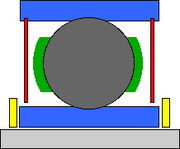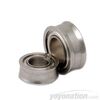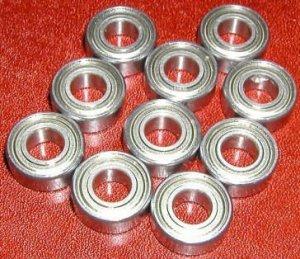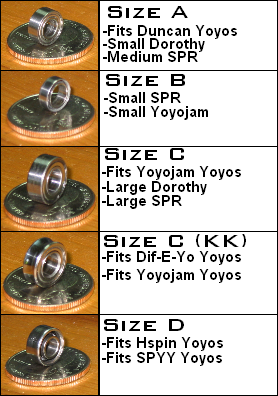Ball bearings, in the context of yo-yo play, were introduced in the early 1990s. They are used to reduce friction while the yo-yo is sleeping. A ball bearing yo-yo can be played in two extreme states. One configuration involves using a thick lubricant in the ball bearing, so that sleep times will be low. This configuration is generally used for looping tricks. The second configuration involves either running a bearing with thin lube in small amounts or cleaning the ball bearing of any lubricant - playing a "dry" bearing. Dry bearings are usually used so yo-yos will be less responsive during string trick play.
Anatomy

Anatomy of a Ball Bearing
As the cross section diagram shows, a ball bearing consists of an outer race (top blue bar), an inner race (bottom blue bar) and balls (grey) that roll in grooves in the races. To keep the balls evenly distributed, some bearings employ a so called cage (green). Since dust inside of the bearing is quite detrimental to its performance, the side walls are often protected by shields (red) that are fixed on - and rotate with - the outer race. The shields can usually be removed by taking out the small steel springs that hold them in place.
In a yo-yo, the bearing is mounted around an axle (light grey) and gripped on the sides by shims (yellow). Since the shields rotate with the outer race, it is very important that the shims do not touch the shields. Many players remove the shields permanently to prevent this, and to allow easier cleaning and inspection.
Materials
- Steel - Historically, most yo-yo ball bearings have been made from steel. Some are stainless, but since stainless steel is much softer than ordinary steel, this reduces the life time of the bearing. That's why many manufactures (like Buzz-On) use non-stainless bearings.
- Ceramic - A more expensive variety use ceramic silicon nitride (Si3N4) balls inside, but retain a stainless steel race and exterior. It is supposesed to sleep even longer but can cost from 7 dollers to over 100 for one bearing.
The quality of a bearing is sometimes given in ABEC numbers. These numbers refer to a scale of roughness of the ball surface, which results in a recommended maximum rpm for a bearing. Usually yo-yo bearings come as ABEC-3, although more expensive bearings, such as the KonKave bearing, are ABEC-7. However, the majority of yo-yoers are of the opinion that ABEC ratings do not make any difference to yo-yo play, as a higher ABEC rating bearing will not spin any longer.
Sizes
There are many different bearing sizes, and knowing what size the bearing is in a yo-yoer's yo-yo is important if they want to upgrade the bearings. Using the Buzz-On SPR kits, it is even possible to modify the size of bearing that fits into a particular yo-yo.
Infinite Illusions sizes
Infinite Illusions uses a lettering system to simplify bearing choices. These are the most common sizes you may run into. The listed measurements are, in order, Inner Diameter x Outer Diameter x Width.
- Size A - The A bearing fits most Duncan, Playmaxx, YoYoFactory, ZanNavi and many other yo-yos. Measures 5mm x 10mm x 4mm.
- Size B - This bearing fits small bearing YoYoJam yo-yos, including SpinFaktors (but not the HG), Kamaitachi, Sunset Trajectory and Matrixx. It also fits the SuperYo Renegade, and the Spintastics Revolver and Eclipse. Measures .250 x .375 x .125 (1/4" x 3/8" x 1/8").
- Size C - Fits the large bearing YoYoJam yo-yos including the Hitman, Lyn Fury, Spinmaster 2 and 3, Big Ben, Patriot, Nightmoves 2 and 3, Shockwave 3, the Speeder and the Speedmaker, as well as the YoYoFactory G5 and 888. Measures .250 x .500 x .187 (1/4" x 1/2" x 3/16").
- Size D - Fits B.I.S.T., HSpin and SPYY yo-yos. Measures 5mm x 11mm x 5mm.
- Size E - Fits the Spintastics Tornado, Tigershark, Riot, Great White, Comet, Torch, and Firefly, and Yomega ball bearing yo-yos. Measures .156 x .312 x .125 (5/32" x 5/16" x 1/8").
Special sizes
These bearings are usually made for a specific yo-yo or specific manufacturer.
- Size G - Fits all Custom yo-yos. Measures .187 x .375 x .125 (3/16" x 3/8" x 1/8").
- Size H - Fits the Sonic Spin and Invader by SuperYo. This bearing is made of plastic.
- Size I - Fits all Tom Kuhn ball bearing yo-yos. Measures .125 x .312 x .140
- Size M - This bearing fits the BigYo 2 by YoYoJam and is only available through special order.
Special Bearings
Over the years there have been a few innovations in ball bearings specially designed for the yo-yo market.
Center Trac

The Center Trac bearing was developed by YoYoFactory to center the string. It is similar in design to the KonKave bearing, but instead of a smooth curved face it is flat with flared edges. YoYoFactory claims that this is to keep the string from bunching up in the center of the bearing.
Dorothy
The Dorothy bearing used in YoYoFactory's premium yo-yos is also intended to be played dry and not cleaned. It has been speculated that they use Teflon coated parts. These bearings were considered to be very temperamental by some yo-yoers as they were prone to locking up and have been replaced in all YoYoFactory premium yo-yos with the newer SPEC bearings.
Gold
The gold bearing got its name from the colour it became due to the treatment process it was given. The gold colour wears off after a few hours of play. It was commissioned by Taka in Japan and initially showed promise of being even better than the ceramic bearings. However, these bearings have shown a decrease in performance in a relatively short period of time after using them in a yo-yo and cannot be cleaned. They have only been sold at Spingear and Infinite Illusions.
KonKave

The KonKave Bearing was developed by Dif-e-Yo. The intention here is to keep the string centered on the bearing and away from the response system. The outer surface of these bearings is (as the name implies) not flat, but slightly concave. Earlier experiments by Dif-e-Yo included a grooved bearing, where the string was kept in a groove running around the outer race. Most Dif-e-Yos come with a KonKave already installed. For many other yo-yos Dif-e-Yo offers conversion kits, the process of upgrading an existing yo-yo thus became known as KonKaving.
Mercury
Another novel variety of bearing is the Mercury bearing. These were first introduced into the main-stream yo-yo hobby market by Infinite Illusions. The mercury bearings, named after the Greek god Mercury, do not contain any elemental mercury. What makes the mercury bearing special is the factory cleaning process which increases spin time and decreases response.
Mercury Fat Lip
These are normal Mercury bearings (see above) that have a wider inner race. This is to make sure that the shims cannot touch the shields.
Phi Bearings
The bearing in the Kyo Phi 1.618 has a special coating (Kyle, the designer, won't go into details) that means it can be played dry. As it is the same size as YoYoJam bearings it can be used in YoYoJam yo-yos and Dif-e-Yo yo-yos. Kyle ran a series of tests to try to determine the best bearing by using a rig to spin the bearings up to a certain speed and to see how long they took to stop spinning which resulting in him selecting this bearing.
Electrodynamic Bearings
The bearing is working with electrodynamic forces induced by a rotor spinning in a permanent magnet field - generating eddy curerents. The technique is not requiring any active controller to operate. Electrodynamic bearingss are supplied by Magnetal AB (www.magnetal.se)
Care
To get the most out of your ball bearing, it requires some care.
Breaking In
A bearing usually does not perform perfectly out of the box, they need some breaking in. This can usually be achieved by throwing a few long sleepers. Some players stick their bearings on the tip of an electric drill in order to break it in, hence the saying "to dremel a bearing". Alternatively, some players do continuous Gyroscopic flops to help break in the bearing.
Cleaning
See article bearing cleaning.
Lubricating
Lubrication is often referred to as lube by yo-yoers. Bearings usually run at their least responsive, when they are 'dry', i.e. all lube has been cleaned out of them. This gives them nearly no response at all. The downside of this is a reduced life span, the possibility of rusting, as well as being significantly more noisy. If you decide to use lube, you should clean the inside of your bearing first to remove any old lube or string lint etc, so you can choose how much or how little lube to use.
Unresponsive yo-yo bearings can be slightly oiled with a thin lube. This keeps them from rusting and significantly reduces noise. The main purpose is to give them slightly less response. Trumpet valve oil is one example of a thin lube that makes the bearing nearly as unresponsive as a dry bearing, although it can attack plastic. Most yo-yo stores however now offer yo-yo specific thin lube, which is more effective and doesn't harm the yo-yo.
For yo-yoers who want more response for looping yo-yos, a thick lube is used in much greater quantities. This is most commonly seen in AA play. This makes the ball bearing nearly as responsive as a fixed axle, but with longer sleep times. Types of thick lubes include petroleum jelly and 3-in-1 oil. This is usually applied without cleaning the outside of the shields, to give them more friction against the yo-yo halves.
Bearing life
Bearings will eventually wear out, however the way you treat them has a great effect on how long they last. Running bearings completely dry will reduce their lifespan and make the bearing more prone to rust. Using a dremel during the cleaning process will also reduce their lifespan significantly. Bearings should also be kept away from magnets, as if the bearing becomes magnetised the balls stick to any metallic grit and wear out very quickly. Finally, storing bearings with in the yo-yo with the string attached for long periods of time is not recommended because the string will absorb moisture and increases the risk of rust.

